|
|

There was a castle at Bristol from around 1080, built by the
Normans. It was strengthened and extended in the early twelfth
century when it played a key role in the power struggle between
King Stephen and his rival to the throne, the Empress Matilda.
The illustration below is an artist's impression from 1922 of
what the castle might have looked like in its heyday.
In later
years its military significance was greatly reduced and it fell
into disrepair. It was partly restored by the Parliamentarians
during the English Civil Wars (1642-51), but was dismantled,
along with the city's defensive walls, on the orders of Oliver
Cromwell in 1655. The area on which it stood, to the east of
the city centre, is now the site of Castle Park (opened in 1978),
where some remnants of the old foundations can still be found.
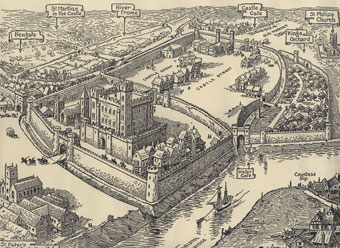
Bristol
Castle in the Days of its Glory F G Lewin
(Bristol Libraries).
Many other landmark buildings have been
lost to the city through warfare or redevelopment programmes.
These include the seventeenth-century Dutch House, on the corner
of Wine Street and High Street, which was destroyed by enemy
bombing on Sunday 24 November 1940 during the Bristol Blitz.
(Read about the Blitz in the Bristol at War story on The
Siege website.) It was a five-storey, timber-framed building, in the
Tudor-style. Its main corner-post, which was carved into a grotesque
howling figure, has been preserved by Bristol's City Museum and
Art Gallery.

The Dutch House by Nathaniel Sparks (1910) (Bristol's
Museums, Galleries and Archives).
George Braikenridge,
a nineteenth-century merchant, collected around 1,400 views of
Bristol, most of which had been specially commissioned in the
period 1820 to 1830. They were bequeathed to Bristol's City Museum
and Art Gallery, and provide an invaluable record of buildings
and streets dating back to the thirteenth century which have
since been bombed, demolished, damaged, fallen into disrepair
or altered beyond recognition. Among these were St Peter's Hospital
(formerly known as The Mint), destroyed in the Blitz, and the
houses of Broker's Alley at the Pithay, knocked down in the 1890s
to make way for the expansion of the J S Fry chocolate factory.
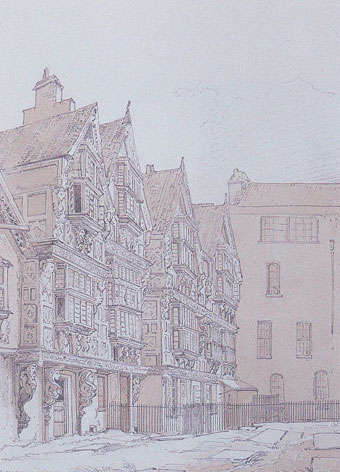
St
Peter's Hospital seen from St Peter's Churchyard by James Johnson,
1821 (Bristol's Museums, Galleries and Archives).
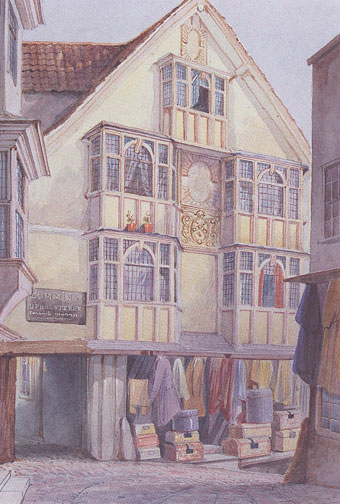
Top of Pithay (Broker's Alley) by Thomas L Rowbotham, 1829 (Bristol's
Museums, Galleries and Archives).
However, many
historic buildings have survived, among the oldest of which is
St Mary Redcliffe, parts of which date back to the twelfth century.
On a visit to the city in 1574 Queen Elizabeth I is alleged to have declared this
to be the 'fairest, goodliest and most famous parish church in
England'.
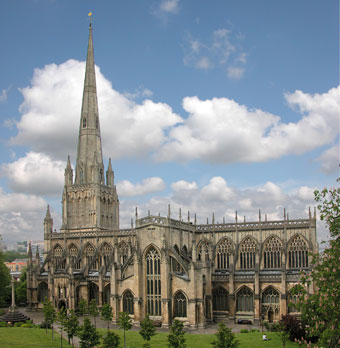
St Mary Redcliffe by John Pickard, c 2006.
Queen Elizabeth granted the charter for the Hospital
School in Bristol that bears her name in 1586. The school was
founded for 'the education of poor children and orphans' using
a bequest by John Carr, a soap merchant. It was at one time based
in St Bartholomew's Hospital, the remains of which can still
be seen near the foot of Christmas Steps, a picturesque alley
running between Lewins Mead and Colston Street in one of the
oldest areas of the city. The hospital was founded in 1240. Its
entrance was through the thirteenth-century archway which is
shown to the right of the picture below. Today, the shop on the
left of this picture is a popular fish and chip shop.
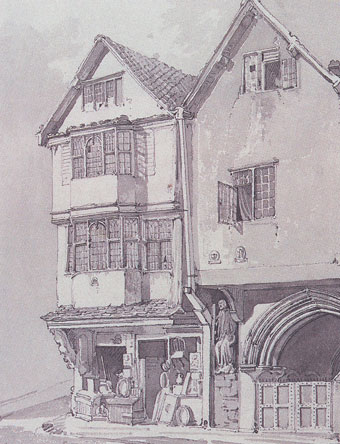
The City
School (Queen Elizabeth's Hospital) in Christmas Street by Hugh
O'Neill, 1820 (Bristol's Museums, Galleries and Archives).
The redbrick building on Brandon Hill that is now home
to Queen Elizabeth Hospital School was built in the 1840s, though
it looks to have come from a much earlier age. In the nineteenth
century a number of previous architectural styles were revived
including the Tudor, the Gothic and the Ancient Greek. St George's
Church on Great George Street, now a concert venue, was built
in 1824 in what was called the new Greek Revival or neo-Classical
style. Its architect, Robert Smirke, designed the British Museum,
another neo-Classical building.
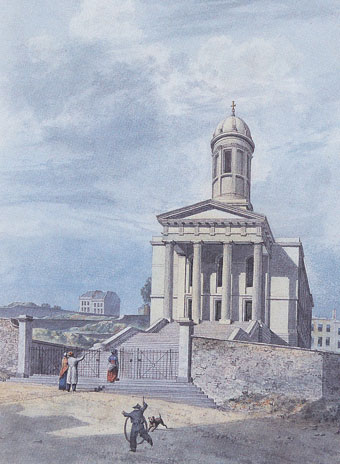
St George's Church, Great George
Street by Edward Cashin, 1824 (Bristol's Museums, Galleries and
Archives).
As befits a city founded on trade,
there are a number of impressive warehouses along the quays of
the Floating Harbour, many of which have now been converted into
apartment blocks after years of neglect. Among the most exotic
is The Granary (1869) on Welsh Back. It is ten storeys high,
built in multicoloured brick and stone with a different window
shape for each floor and a roof that looks like a battlement.
It is one of the best remaining examples of nineteenth-century
Bristol Byzantine, a style that combined elements of Gothic,
Moorish, North Italian and Venetian design.
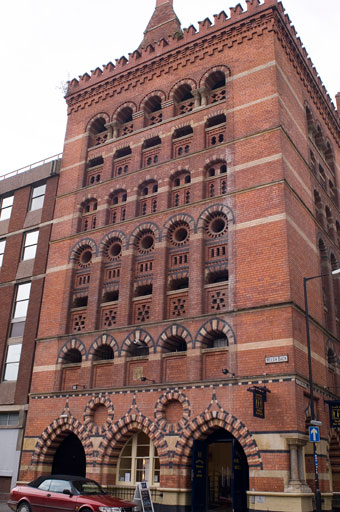
The Granary, photograph
by Ian Blantern, 2006.
At the bottom of Broad
Street is a beautifully decorated Art Nouveau building from the
beginning of the twentieth century that used to house the Edward
Everard printing works. The figures you can see depicted in the
mural are the printers Gutenberg and William Morris, the Spirit
of Literature and a woman holding up a lamp and a mirror to represent
Light and Truth.
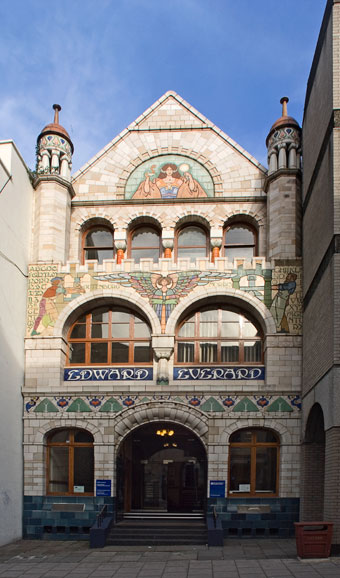
The Edward Everard printing works, photograph
by Ian Blantern, 2006.
At the top of Park Street,
is the Wills Memorial Building of the University of Bristol.
Its tower, a prominent city landmark, is over 65 metres tall.
The building was built in honour of Henry Overton Wills, the
tobacco manufacturer, who had donated money to the university,
and it was completed in 1925.

Architectural drawing for the tower
of the Wills' building, 1914. (Special Collections, University
of Bristol).
Adjacent to Explore At-Bristol on Millennium Square is the planetarium.
Its chrome sphere is probably one of the most-photographed structures
in Bristol.
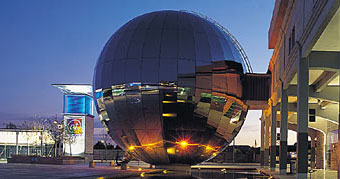
The planetarium at Explore
At-Bristol.
In autumn 2008 Cabot Circus is
due to open at what was formerly known as Broadmead. This is
the largest city centre regeneration programme in Bristol since
the reconstruction that followed World War Two.
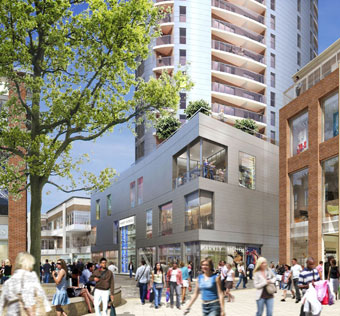
Computer-generated
image of the Harvey
Nichols shop at Cabot Circus.
|
|

What is your favourite Bristol building? Submit your nomination via the My
Bristol page.
|
| |